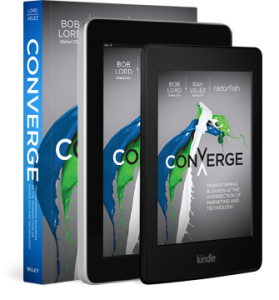Brand Book Bites from Converge
(“brand book bites” are book write-ups that highlight the most interesting brand stories in the latest best-selling books. Subscribe to my feed so you don’t miss these regular bulleted briefings on the books I recommend.)
– the book: Converge: Transforming Business at the Intersection of Marketing and Technology – the ultimate business card for Razorfish, one of the original digital marketing agencies
– the brains: Bob Lord who was Razorfish’s Global CEO until he took the reins at AOL Networks a couple months back, and Ray Velez, Global CTO of the agency, who I enjoyed spending a few moments with talking about the book
– the best bits:
Converge is about, well, convergence – but I found the authors’ definition of convergence to be illuminating: “Convergence is the coming together of three irresistible forces – media, technology, and creativity – to meet an immovable object: the enterprise.” Actually they call it a “collision” and they offer the book as a roadmap for understanding and then navigating through the mash-up.
The book outlines the five principles practiced by companies that excel at Convergence:
- customer centricity – structure your organization around the customer journey
- reject silos – enabling better collaboration among marketing, technology, and creative functions
- act like a start-up – approaching technology and organizational structure with agility and rapid prototyping
- cross-disciplinary mindset – looking for intersections where innovation can occur and removing associative barriers
- think of your brand as a service – instead of selling stuff, you’re in the business of filing customers’ needs (see my brand book bite on Youtility for more on this topic)
– the brand story:
The authors describe the new reality of marketing saying, “The commerce experience for your consumers is one of your strongest marketing opportunities…the transaction is now the center of a cyclical and continuous brand experience.” In short, “marketing is commerce and commerce is marketing.”
As an example, they point to Moosejaw, a 14-unit chain of outdoor outfitters (I’ve been a fan of Moosejaw for many years – see this post of mine from 2009!)
Behind the brand’s irreverent personality is a powerful commerce engine designed to serve a customer “an amazingly delightful experience” in any channel. Moosejaw service reps use cash registers to access the same view of product, pricing, inventory, marketing, promotions, and customers as its salespeople have when they’re using iPod Touches to help them interact with customers. As such, Moosejaw people “know what they need to know to improve the shopping experience and…customers have come to view them as sources of knowledge.”
As Ray says, “It’s an amazing quirky standout brand that sets itself apart because they’re not using traditional media to create the brand – instead they’re putting the customer in the center and using creative excellence.”
– the bottom line: The implications of Convergence on brand-building is made clear in the authors’ observation that business is shifting from “one unique big-brand message that’s packed up into a set of ‘matching luggage’ to multiple ideas for multiple audiences based on a single coherent brand platform.”
(This write-up is part of a Post2Post Virtual Book Tour – check out other write-ups by Scott Brinker, Renee Hopkins, William Eisenbrandt, and Jason Korman.)
other brand book bites:
- Youtility by Jay Baer
- The Business of Belief by Tom Asacker
- Can’t Buy Me Like by Bob Garfield and Doug Levy